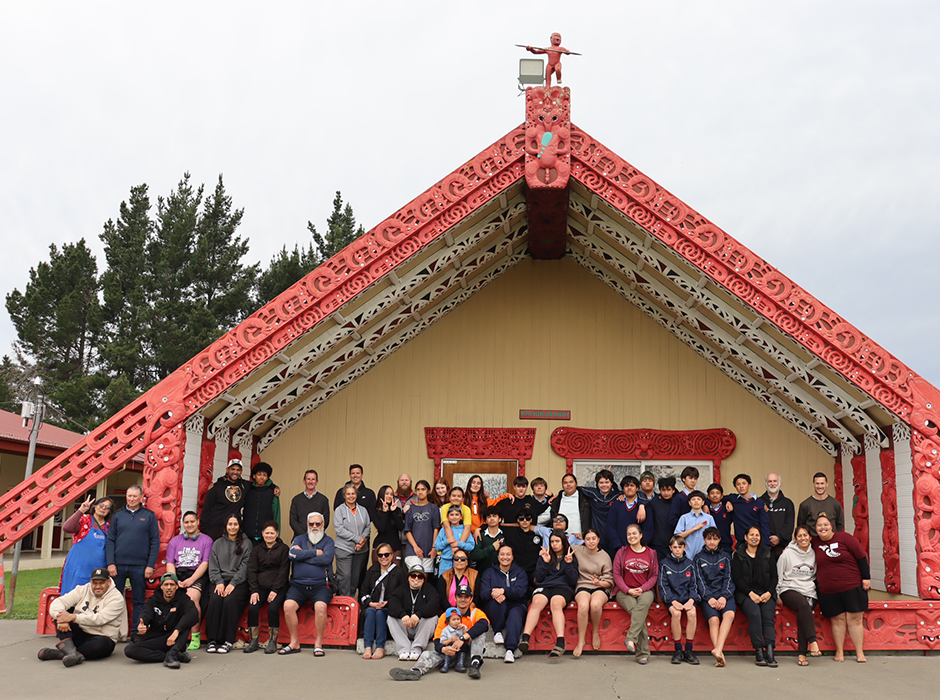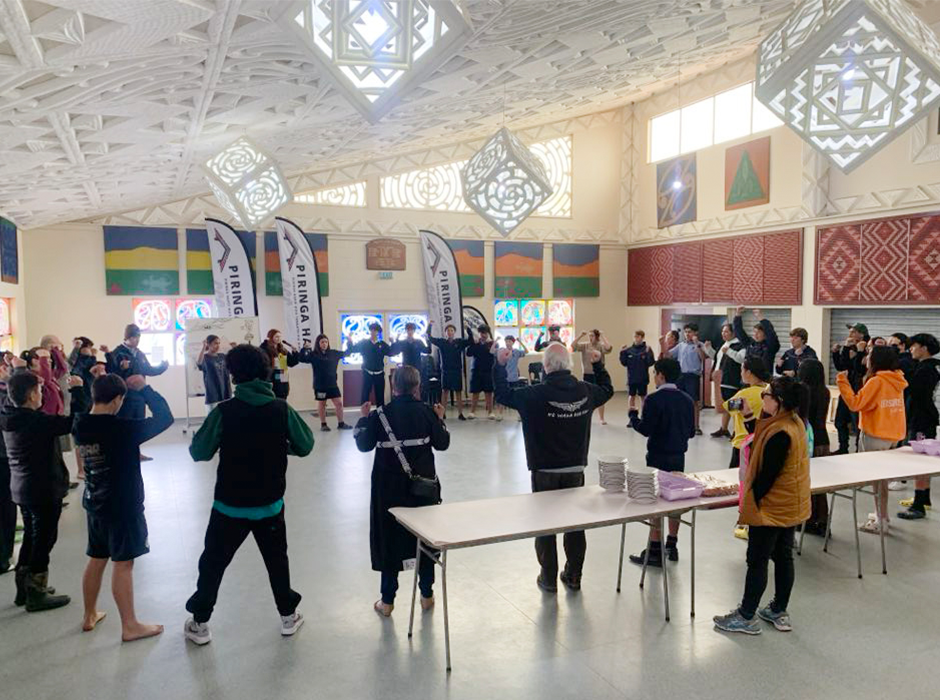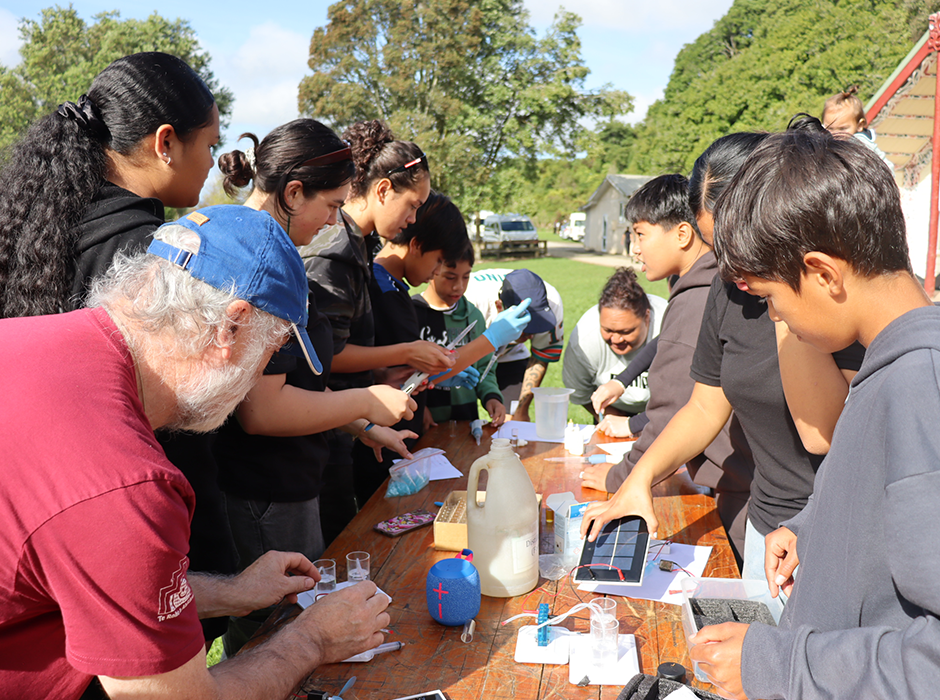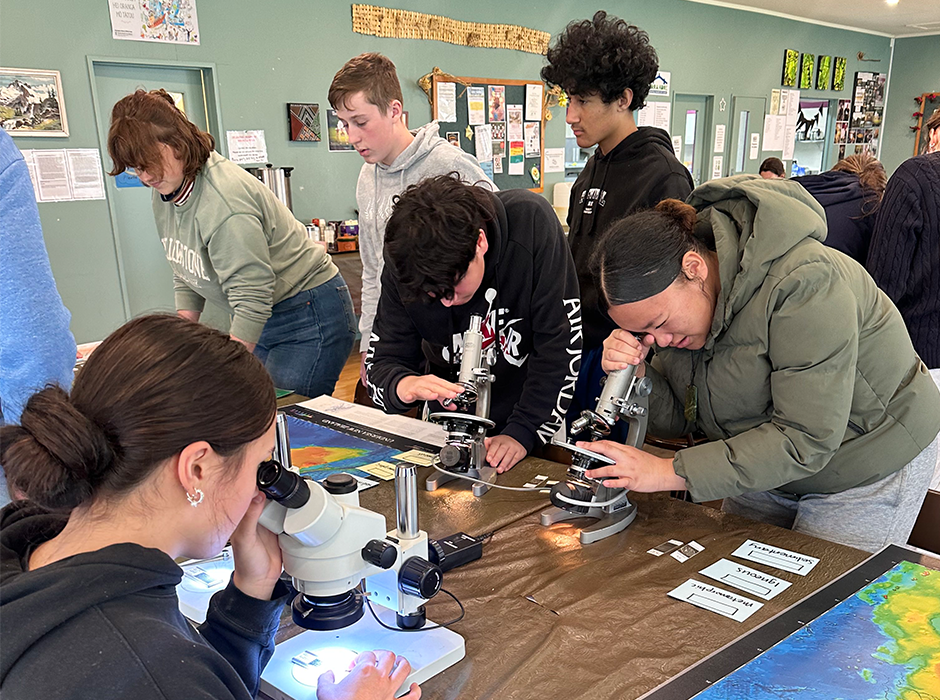
The 50th Science Wānanga held recently at Omāhu marae in Heretaunga (Hastings). Mariana Te Pou, Kaituitui Wānanga, is in the front row at far right.
Nurturing the scientific and curious minds of rangatahi Māori across the motu has been at the heart of Science Wānanga since Te Rohe a Ahikāroa (Division of Sciences) started hosting it in 2008. Reaching the 50th Science Wānanga, held recently in Heretaunga (Hastings), was a milestone and time of reflection for the kaupapa.
At this Wānanga, in partnership with Te Taiwhenua o Heretaunga and Te Piringa Hapū of Ngāti Kahungunu, kaimahi and tauira from Ōtākou Whakaihu Waka engaged with 26 rangatahi Māori for five days of pūtaiao focused on the health of the local taiao.
Mariana Te Pou, Kaituitui Wānanga, explains the science activities organised for each wānanga respond to the needs and aspirations of the local mana whenua.
“Hapū wanted to learn more about the health of their awa (river), roto (lakes) and the air they breathe, so we spent the week doing science activities revolving around these ecosystems,” Mariana says.
“Rangatahi Māori thrive in te taiao when doing hands-on activities that are fun, contributes to their communities and help to learn about science. Our mahi helps plant the seed and supports their aspiration to restore these places to the flourishing ecosystems they used to be.”
Based at Rūnanga marae and Omāhu marae, the 50th Science Wānanga included science activities measuring air and water quality, and extracting eDNA from the local waterways for sequencing. Equipment and expertise for the Wānanga were provided by the Department of Chemistry, Department of Zoology, and Te Whai Ao Dodd-Walls Centre.
Mātauranga Māori and kaupapa Māori weaved through the activities including hapū contributing historical kōrero about the awa and roto at the locations of eDNA collection. At the end of the Wānanga, rangatahi worked together to create science skits and games to share the mātauranga pūtaiao they learned, with whānau, marae community and hapū delegates.
Mariana joined Science Wānanga as a tuakana in 2013 when she was a postgraduate student with a BSc in Anatomy. A key strength of the programme has been the ability to take University students back to their own marae or rohe they grew up in, and to facilitate tuakana-teina connections with their own whānau.
This was a kaupapa that resonated with Mariana, who held various roles before becoming Kaituitui Wānanga in 2020. With a background of postgraduate studies in public health, science communication and a Masters of Entrepreneurship, Mariana says leading the Wānanga allows her to be creative as she evolves the programme.
“I was very fortunate having parents who took us back home to our marae when we were younger, our place of learning whakapapa, tikanga and kawa, te reo Māori, manaakitanga, kaitiakitanga, waiata, kōrero tawhito, pūrākau and so much more.
“Having the Science Wānanga take place on marae encompassing all of that and then intertwining both worlds of mātauranga Māori and science is super cool. As soon as you hear the karanga you feel the wairua and mauri guiding you and everyone knows what they are there for.
“Every day on the marae is a learning day for the rangatahi Māori, kaiako from the kura, and the kaimahi and tauira from Ōtākou Whakaihu Waka.”
Beginnings

Rangatahi Māori created a game to share their learnings about the different kaupapa taught on Science Wānanga with whānau and haukainga (local people) at Omāhu Marae.
In September 2008 the first Science Wānanga was hosted by Hauiti Marae, Tolaga Bay, and attended by rangatahi and kaimahi from four local schools. It was initiated as a request from the late Dr Paratene Ngata to assist more Ngāti Porou rangatahi to achieve in sciences and health sciences.
Developed by Dr Stephen Scott (Ngāti Whātua) and Rose Newburn from Te Rohe a Ahikāroa, the wānanga presented a range of projects including ocean acidification and how drugs and alcohol affect the body.
Since the success of that inaugural Science Wānanga, the programme has gained momentum and been held across the motu from Kenana Marae in Kaitaia to Te Rau Aroha Marae in Bluff. Over the 50 wānanga to date, more than 2000 rangatahi Māori spanning Years 7 to 13 have participated in the programme.
For Hiria Palmer (Ngāi te Rangi, Ngāti Rangi, Te Atihaunui-a-Pāpārangi), who attended the 50th Science Wānanga as a guest with the hosting iwi rōpū Te Taiwhenua o Heretaunga, returning to the mana whenua was poignant.
In 2014, when Hiria became Kaituitui Wānanga of Science Wānanga, she worked with Te Taiwhenua o Heretaunga to pivot the programme’s aspirations from school- to iwi-driven imperatives.
“We wanted to find out what the significant science issues were for each rohe that we, Ōtākou Whakaihu Waka, could support through the delivery of Science Wānanga,” Hiria says.
Attending the 50th Science Wānanga, she was pleased to observe the growing empowerment of hapū and their ambition to lead and influence their destinies.
“We are moving from iwi-based partnerships to mana-to-mana agreements at hapū level. I find this most applicable as we move back to our traditional ways of living where hapū are at the forefront and thriving.”
Hiria commends the leadership of Mariana who has evolved the programme into an integrated and seamless operation full of fun, practical and meaningful activities.
“Mariana’s affinity and empathy with rangatahi are her greatest attributes and her confidence provided a boost that all involved continually needed over the week. She is truly gifted and does a fantastic job.”
The spirit of kohatikanga

Rangatahi and kaiako compete in a Science Amazing Race competition at Science Wānanga held at Oparure Marae.
Hosted by the Division of Sciences, the Science Wānanga kaupapa has strengthened over the 50 wānanga due to the collaborations and partnerships developed since 2008. These partnerships continue to foster and grow connections between local mana whenua, kura and rangatahi, together with the expertise and support of kaimahi and tauira of the University.
Mariana says that kaimahi with expertise in a wide range of sciences participate in wānanga from across the Divisions of Sciences and Health Sciences.
“Scientists attending wānanga are experts in their fields, and we have Māori and tauiwi scientists who support the kaupapa and aspirations of iwi and hapū. We provide cultural guidance and support to our scientists and tauira before going onto the marae, ensuring that they feel well informed, prepared and ready to do the mahi on marae,” Mariana says.
“We also love giving tauira the opportunity to be tuakana on the programme, especially when they return to their own marae. Their younger spirit and energy resonate with the rangatahi, which makes them great role models who support learning, fun and engaging with pūtaiao.”
Planting the seed

Hosted recently at Araiteuru marae, local Ōtepoti rangatahi learned about geology including faults, volcanism and erosion.
Associate Dean Māori (Sciences), Associate Professor Tracy Perry (Ngāti Porou, Ngāti Uepohatu, Waikato, Ngāti Wairere) says Mariana’s mahi building relationships with hapū and iwi have been vital in shaping Science Wānanga.
“In the last two years alone this mahi has led to the successful delivery of up to 14 Science Wānanga, with up to 600 rangatahi Māori participating in science activities ranging from chemistry and genetics to physics, biochemistry, geology, whenua, wai, hau, biodiversity, taiao, and taonga,” Tracy says.
“As Ōtākou Whakaihu Waka moves forward under the Pae Tata and Māori Strategic Framework strategies, this is an exciting time for the Science Wānanga to flourish. By being Te Tiriti-led, the programme will continue to uplift our Māori communities and inspire rangatahi ensuring they benefit from the richness of this kaupapa to become the science leaders of the future.”
Mariana says Science Wānanga is about inspiring rangatahi Māori as the next generation by planting the seed and sparking the interest in sciences. “Poipoia te kākano kia puāwai is one of the whakatauki that guides my mahi while on Science Wānanga - nurturing our tamariki and mokopuna so they too can flourish.”
“It can be a few years after rangatahi have attended Science Wānanga, but often we see their familiar faces here at Otago at Te Huka Mātauraka first-year Māori welcome pōwhiri ceremony. Seeing them again is the best feeling and brings a huge smile to my face.”